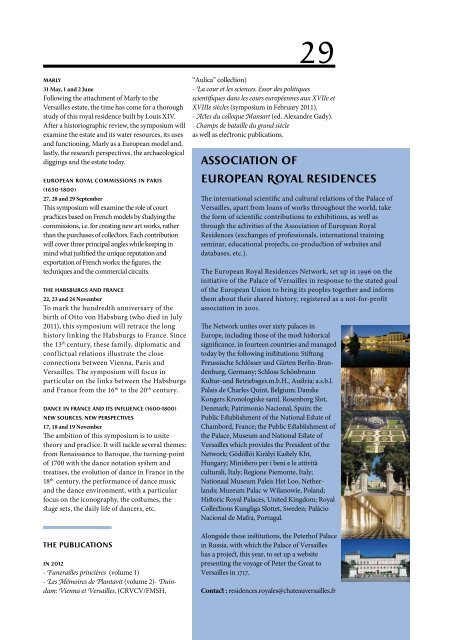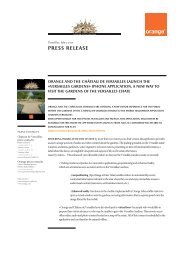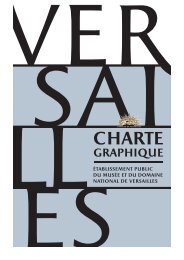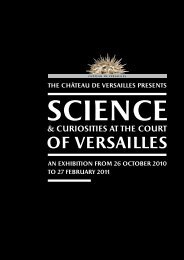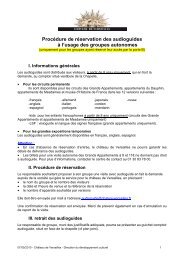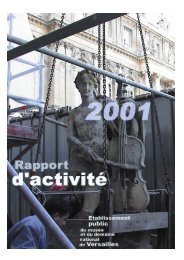Press Release - Versailles - Château de Versailles
Press Release - Versailles - Château de Versailles
Press Release - Versailles - Château de Versailles
Create successful ePaper yourself
Turn your PDF publications into a flip-book with our unique Google optimized e-Paper software.
Marly<br />
31 May, 1 and 2 June<br />
Following the attachment of Marly to the<br />
<strong>Versailles</strong> estate, the time has come for a thorough<br />
study of this royal resi<strong>de</strong>nce built by Louis XIV.<br />
After a historiographic review, the symposium will<br />
examine the estate and its water resources, its uses<br />
and functioning, Marly as a European mo<strong>de</strong>l and,<br />
lastly, the research perspectives, the archaeological<br />
diggings and the estate today.<br />
european royal Commissions in Paris<br />
(1650-1800)<br />
27, 28 and 29 September<br />
This symposium will examine the role of court<br />
practices based on French mo<strong>de</strong>ls by studying the<br />
commissions, i.e. for creating new art works, rather<br />
than the purchases of collectors. Each contribution<br />
will cover three principal angles while keeping in<br />
mind what justified the unique reputation and<br />
exportation of French works: the figures, the<br />
techniques and the commercial circuits.<br />
The Habsburgs and France<br />
22, 23 and 24 November<br />
To mark the hundredth anniversary of the<br />
birth of Otto von Habsburg (who died in July<br />
2011), this symposium will retrace the long<br />
history linking the Habsburgs to France. Since<br />
the 13th century, these family, diplomatic and<br />
conflictual relations illustrate the close<br />
connections between Vienna, Paris and<br />
<strong>Versailles</strong>. The symposium will focus in<br />
particular on the links between the Habsburgs<br />
and France from the 16th to the 20th century.<br />
dance in France and its influence (1600-1800)<br />
New sources, new perspectives<br />
17, 18 and 19 November<br />
The ambition of this symposium is to unite<br />
theory and practice. It will tackle several themes:<br />
from Renaissance to Baroque, the turning-point<br />
of 1700 with the dance notation system and<br />
treatises, the evolution of dance in France in the<br />
18th century, the performance of dance music<br />
and the dance environment, with a particular<br />
focus on the iconography, the costumes, the<br />
stage sets, the daily life of dancers, etc.<br />
The publications<br />
In 2012<br />
- Funerailles princières (volume 1)<br />
- Les Mémoires <strong>de</strong> Plantavit (volume 2)- Duindam:<br />
Vienna et <strong>Versailles</strong>, (CRVCV/FMSH,<br />
29<br />
“Aulica” collection)<br />
- La cour et les sciences. Essor <strong>de</strong>s politiques<br />
scientifiques dans les cours européennes aux XVIIe et<br />
XVIIIe siècles (symposium in February 2011).<br />
- Actes du colloque Mansart (ed. Alexandre Gady).<br />
- Champs <strong>de</strong> bataille du grand siècle<br />
as well as electronic publications.<br />
Association of<br />
european ROYAl resi<strong>de</strong>nces<br />
The international scientific and cultural relations of the Palace of<br />
<strong>Versailles</strong>, apart from loans of works throughout the world, take<br />
the form of scientific contributions to exhibitions, as well as<br />
through the activities of the Association of European Royal<br />
Resi<strong>de</strong>nces (exchanges of professionals, international training<br />
seminar, educational projects, co-production of websites and<br />
databases, etc.).<br />
The European Royal Resi<strong>de</strong>nces Network, set up in 1996 on the<br />
initiative of the Palace of <strong>Versailles</strong> in response to the stated goal<br />
of the European Union to bring its peoples together and inform<br />
them about their shared history, registered as a not-for-profit<br />
association in 2001.<br />
The Network unites over sixty palaces in<br />
Europe, including those of the most historical<br />
significance, in fourteen countries and managed<br />
today by the following institutions: Stiftung<br />
Preussische Schlösser und Gärten Berlin-Bran<strong>de</strong>nburg,<br />
Germany; Schloss Schönbrunn<br />
Kultur-und Betriebsges.m.b.H., Austria; a.s.b.l.<br />
Palais <strong>de</strong> Charles Quint, Belgium; Danske<br />
Kongers Kronologiske saml. Rosenborg Slot,<br />
Denmark; Patrimonio Nacional, Spain; the<br />
Public Establishment of the National Estate of<br />
Chambord, France; the Public Establishment of<br />
the Palace, Museum and National Estate of<br />
<strong>Versailles</strong> which provi<strong>de</strong>s the Presi<strong>de</strong>nt of the<br />
Network; Gödöllöi Királyi Kastely Kht,<br />
Hungary; Ministero per i beni e le attività<br />
culturali, Italy; Regione Piemonte, Italy;<br />
Nationaal Museum Paleis Het Loo, Netherlands;<br />
Muzeum Palac w Wilanowie, Poland;<br />
Historic Royal Palaces, United Kingdom; Royal<br />
Collections Kungliga Slottet, Swe<strong>de</strong>n; Palácio<br />
Nacional <strong>de</strong> Mafra, Portugal.<br />
Alongsi<strong>de</strong> these institutions, the Peterhof Palace<br />
in Russia, with which the Palace of <strong>Versailles</strong><br />
has a project, this year, to set up a website<br />
presenting the voyage of Peter the Great to<br />
<strong>Versailles</strong> in 1717.<br />
Contact : resi<strong>de</strong>nces.royales@chateauversailles.fr


